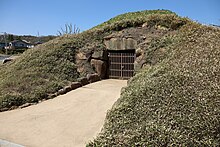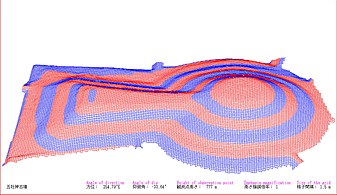Kofun
Kofun (古墳, from Sino-Japanese "ancient grave") are megalithic tombs or tumuli in Northeast Asia. Kofun were mainly constructed in the Japanese archipelago between the middle of the 3rd century to the early 7th century CE.[1]
The term is the origin of the name of the
Overview
The kofun tumuli have assumed various shapes throughout history. The most common type of kofun is known as a
Kofun range from several metres to over 400 m long. The largest, which has been attributed to
The funeral chamber was located beneath the round part and comprised a group of megaliths. In 1972, the unlooted
Locations and number
Kofun burial mounds and their remains have been found all over Japan, including remote islands such as Nishinoshima.[6]
A total of 161,560 kofun tomb sites have been found as of 2001. Hyōgo Prefecture has the most of all prefectures (16,577 sites), and Chiba Prefecture has the second most (13,112 sites).[7]
History


Yayoi period
Most of the tombs of chiefs in the
Another prevalent type of Yayoi period tomb is the Yosumi tosshutsugata funkyūbo, a square mound with protruding corners. These tombs were built in the San'in region, a coastal area off the Sea of Japan. Unearthed articles indicate the existence of alliances between native tribes in the region.
Early Kofun period

One of the first keyhole-shaped kofun was built in the
Mid-Kofun period
During the 5th century AD, the construction of keyhole kofun began in
A few tombs from the mid-Baekje era were excavated around the Yeongsan River basin in South Korea.[citation needed] The design of these tombs are notably different. The tombs that were discovered on the Korean peninsula were built between the 5th and 6th centuries CE.[citation needed] There remain questions about who were buried in these tombs such as nobility, aristocracy, warriors or mercenaries.
- Gallery
-
An example of keyhole-shaped mound in the Early Kofun period which was drawn inNara, Nara), 4th century)
-
An example of keyhole-shaped mound in the Mid-Kofun period which was drawn in 3DCG.
(Fujiidera, Osaka), 5th century) -
An example of keyhole-shaped mound in the Late Kofun period which was drawn in 3DCG.
(Danpusan Kofun (Nagoya), 6th century)
Late Kofun period
Keyhole-shaped kofun disappeared in the late 6th century AD, probably due to the drastic reformation in the Yamato court, where Nihon Shoki records the introduction of Buddhism during this era.
Types
Round Kofun

Square Kofun

Scallop Kofun

Famous examples include Hokenoyama Kofun in the Makimuku ruins.[13][14]: 249 dated to around 250 AD.[14]: 253 and Nyotaizan Kofun.
Octagonal Kofun

Many Japanese Emperors were buried in them including
From the end of the 6th century to the beginning of the 7th, the tumuli of the monarchs changed from
List of Octagonal Kofun
- Ise Kofun (Fujioka City)
- Inari Kofun
- Oichi No.1 Kofun
- Kajiyama Kofun
- Kengoshizuka Kofun
- Gobyo Kofun
- Takei temple ruins
- Dannozuka Kofun
- Tsukamyojin Kofun
- Nakaoyama Kofun
- Nakayamasōen Kofun
- King Noguchi Kofun
- Mitsuya Kofun
- Yoshida Kofun
Zenpō-kōhō-fun


There is a specific style exemplified by
Joenkahofun

They are associated with the
Musashi Fuchū Kumano Jinja Kofun in Fuchū in Tokyo,[29] and Miyazuka Kofun are two notable examples.[29]
List of Joenkahofun
- Ishino Karato Kofun
- Sanno-zuka Ancient Tomb
- Shimizu Yanagikita No. 1 Tomb
- Tenmondai Kounai Kofun
- Nochi Kubo Ancient Tomb
- Miyazuka Kofun
- Musashi Fuchū Kumano Jinja Kofun
Corridor-type kofun

Zenpokoenfun
Zenpokoenfun are a notable type of Japanese ancient tombs (Kofun), which consists of a square front part (前方部) and a circular back part (後円部).[33] The part connecting the two is called the middle part (くびれ部), which looks like a keyhole when viewed from above.[34]
UNESCO Kofun Group
This list includes the "Mozu-Furuichi Kofun Group: Mounded Tombs of Ancient Japan",[35] which was inscribed as a UNESCO World Heritage Site on 6 July 2019.[36]
Aerial photos
-
Oyamato, Yanagimoto and Makimuku Kofun Group, Nara Prefecture, 3rd century
-
Saki Tatanami Kofun Group and the Heijō-kyō site, Nara Prefecture, 4th century
-
Furuichi Kofun Group, Osaka Prefecture, 5th century
See also
- William Gowland, a British engineer who made the first survey for Saki kofun group
- Ernest Satow, a British diplomat who wrote about kofun in Kozuke for the Asiatic Society of Japan
- Fukiishi, stones used to cover kofun
- Kofun system
- Zenpokoenfun
- empun]
- square-type kofun]
- zenpō-kōhō-fun] (前方後方墳)
- hotategai-gata]
- Octagonal Kofun]
- corridor-type kofun] (横穴式石室, yokoana-shiki sekishitsu)
- Joenkahofun]
Notes
- ISBN 978-4479840657
- ^ "Mozu-Furuichi Kofungun, Ancient Tumulus Clusters". UNESCO. Retrieved 18 May 2011.
- ^ "Asuka-Fujiwara: Archaeological sites of Japan's Ancient Capitals and Related Properties". UNESCO. Retrieved 18 May 2011.
- ^ "Database of National Cultural Properties". Agency for Cultural Affairs. Retrieved 14 May 2011.
- ^ "Database of National Cultural Properties". Agency for Cultural Affairs. Retrieved 14 May 2011.
- ^ 島根県遺跡データベース Archaeological Database of Shimane(Japanese)
- ^ 兵庫県教育委員会 兵庫県の遺跡・遺物数の全国的な位置(pdf file, Japanese)
- ^ Krako-kagi Archaeological Museum (2013). "たわらもと2013発掘速報展". Comprehensive Database of Archaeological Site Reports in Japan. Retrieved 2016-09-01.
- ^ "About kofun -Scale and order- | Nonaka Kofun-Project for the Preservation and Utilization of Artifacts from Nonaka Kofun/Osaka University Department of Archaeology". www.let.osaka-u.ac.jp. Retrieved 2023-11-10.
- ^ "About kofun -Scale and order- | Nonaka Kofun-Project for the Preservation and Utilization of Artifacts from Nonaka Kofun/Osaka University Department of Archaeology". www.let.osaka-u.ac.jp. Retrieved 2023-10-20.
- ^ admin (2022-10-24). "iCLA Students Study Ancient Burial Mound with Dr. Darren Ashmore". International College of Liberal Arts (iCLA). Retrieved 2023-10-23.
- ^ Mozu-Furuichi Kofun Group. Chapter 2: Description (PDF). pp. 21–163.
- ^ "Hokenoyama Kofun - Long Barrow in Japan in Honshū". The Megalithic Portal. Retrieved 2023-11-10.
- ^ ISBN 978-0-8248-6284-8, retrieved 2023-11-10
- ^ a b "Kengoshizuka Kofun Tumulus, Koshitsuka-gomon Kofun Tumulus". Exploring the Footsteps of the Heroines of Asuka. Retrieved 2023-10-20.
- ^ a b "Octagonal burial mound said to belong to ancient Japan empress reconstructed in Nara Pref". Mainichi Daily News. 2022-03-04. Retrieved 2023-10-20.
- ^ https://www.megalithic.co.uk/article.php?sid=33021. Retrieved 2023-10-21.
{{cite web}}: Missing or empty|title=(help) - ^ Hays, Jeffrey. "ASUKA, FUJIWARA AND ASUKA-ERA CITIES AND TOMBS | Facts and Details". factsanddetails.com. Retrieved 2023-10-20.
- ^ "Dan-no-tsuka Kofun [Dannotsuka Kofun 段ノ塚古墳, Jomei Tennō-ryō Jomei Tennnoryo 舒明天皇] Passage Grave : The Megalithic Portal and Megalith Map". 2023-10-16. Archived from the original on 2023-10-16. Retrieved 2023-10-20.
- ^ Niiro 1992, p. 160.
- ^ a b "About kofun -Scale and order- | Nonaka Kofun-Project for the Preservation and Utilization of Artifacts from Nonaka Kofun/Osaka University Department of Archaeology". www.let.osaka-u.ac.jp. Retrieved 2023-10-19.
- ISBN 978-1-80327-321-1.
- ISBN 978-1-80327-321-1.
- ISBN 978-1-64642-211-1.
- ^ ISBN 978-4311750403.(in Japanese)
- ^ a b c "Nara National Research Institute for Cultural Properties". www.nabunken.go.jp. Retrieved 2023-10-20.
- ^ a b c "Kofun Culture". www.t-net.ne.jp. Retrieved 2023-10-20.
- ^ a b Hays, Jeffrey. "ASUKA, FUJIWARA AND ASUKA-ERA CITIES AND TOMBS | Facts and Details". factsanddetails.com. Retrieved 2023-10-20.
- ^ ISBN 978-4311750403.(in Japanese)
- ^ "Sakushima Ancient Tomb Mounds (Kofun) – 西尾観光". nishiokanko.com. Retrieved 2023-10-23.
- ^ "Unique burial concepts: Diversity of tomb systems|Southern Kyushu's Remarkable Kofun Culture|Kofun as World Cultural Heritage". www.miyazaki-archive.jp. Retrieved 2023-10-23.
- ^ https://www.rekihaku.ac.jp/english/outline/publication/ronbun/ronbun9/pdf/217011.pdf
- ^ "前方後円墳". Kotobank (in Japanese).
- ^ "What are these keyhole-shaped mounds?". BBC. 2019-10-03. Archived from the original on 2020-11-16. Retrieved 2020-10-13.
- ^ "Mozu-Furuichi Kofun Group: Mounded Tombs of Ancient Japan". UNESCO. 6 July 2019.
- ^ "Seven cultural sites inscribed on UNESCO's World Heritage List". UNESCO. 6 July 2019.
References
- 飛鳥高松塚 (Takamatsuzuka, Asuka), 橿原考古学研究所編, 明日香村, 1972.
- 前方後円墳 (Keyhole-shaped kofun), 上田宏範, 学生社, 東京, 1969.
- 前方後円墳と古代日朝関係 (Keyhole-shaped kofun and diplomatic relations between ancient Japan and Korea), 朝鮮学会編, 東京, 同成社, 2002.
- Niiro, Izumi (1992). "V古墳時代 2古墳 a前・中期". Zukai Nihon no jinrui iseki 図解・日本の人類遺跡. Tokyo Diagaku Shuppankai. ISBN 4-13-026200-9.
External links
- Kofun - World History Encyclopedia
- Japanese Archaeology: Kofun Culture
- (In Japanese) Decorated Kofun Database
- Comprehensive Database of Archaeological Site Reports in Japan, Nara National Research Institute for Cultural Properties


![An example of keyhole-shaped mound in the Mid-Kofun period which was drawn in 3DCG. (Nakatsuyama Kofun [ja] (Fujiidera, Osaka), 5th century)](http://upload.wikimedia.org/wikipedia/commons/thumb/2/2b/CG_Nakatsuyama_kofun_Southeast.jpg/337px-CG_Nakatsuyama_kofun_Southeast.jpg)



